Hackshaw v. Shaw [1984] 155 CLR 614: A Detailed Case Analysis
VerifiedAdded on 2020/03/23
|8
|2433
|632
Case Study
AI Summary
This case study provides a detailed analysis of the landmark Australian High Court case, Hackshaw v. Shaw [1984] 155 CLR 614. The case revolves around the issue of the duty of care owed by an occupier of land to a trespasser. The facts involve a farm owner who, after repeated thefts, sets up a trap involving a firearm to catch the thieves. A sixteen-year-old girl, a trespasser, is shot and injured. The study examines the arguments presented by both the plaintiff and the defendant, focusing on whether the defendant owed a duty of care to the plaintiff, and whether the use of the firearm was justified. The judgment of the court, which found in favor of the plaintiff, is critically analyzed, focusing on the reasons provided by the court, including the foreseeability of harm, the dangerous nature of the defendant's actions, and the application of the duty of care to trespassers. The analysis references key legal precedents and principles, such as Donoghue v. Stevenson and the concept of a 'neighbor' in the context of negligence law.

1
Contents
HACKSHAW V. SHAW [1984] 155 CLR 614...........................................................................................2
Case introduction.....................................................................................................................................2
The facts of the case................................................................................................................................2
The issues raised by both plaintiff and defendant....................................................................................3
The arguments presented by both parties.................................................................................................3
The judgment of the court........................................................................................................................4
Critical analysis of why the court decided in favor of the party...............................................................4
Reference List.............................................................................................................................................6
Contents
HACKSHAW V. SHAW [1984] 155 CLR 614...........................................................................................2
Case introduction.....................................................................................................................................2
The facts of the case................................................................................................................................2
The issues raised by both plaintiff and defendant....................................................................................3
The arguments presented by both parties.................................................................................................3
The judgment of the court........................................................................................................................4
Critical analysis of why the court decided in favor of the party...............................................................4
Reference List.............................................................................................................................................6
Paraphrase This Document
Need a fresh take? Get an instant paraphrase of this document with our AI Paraphraser
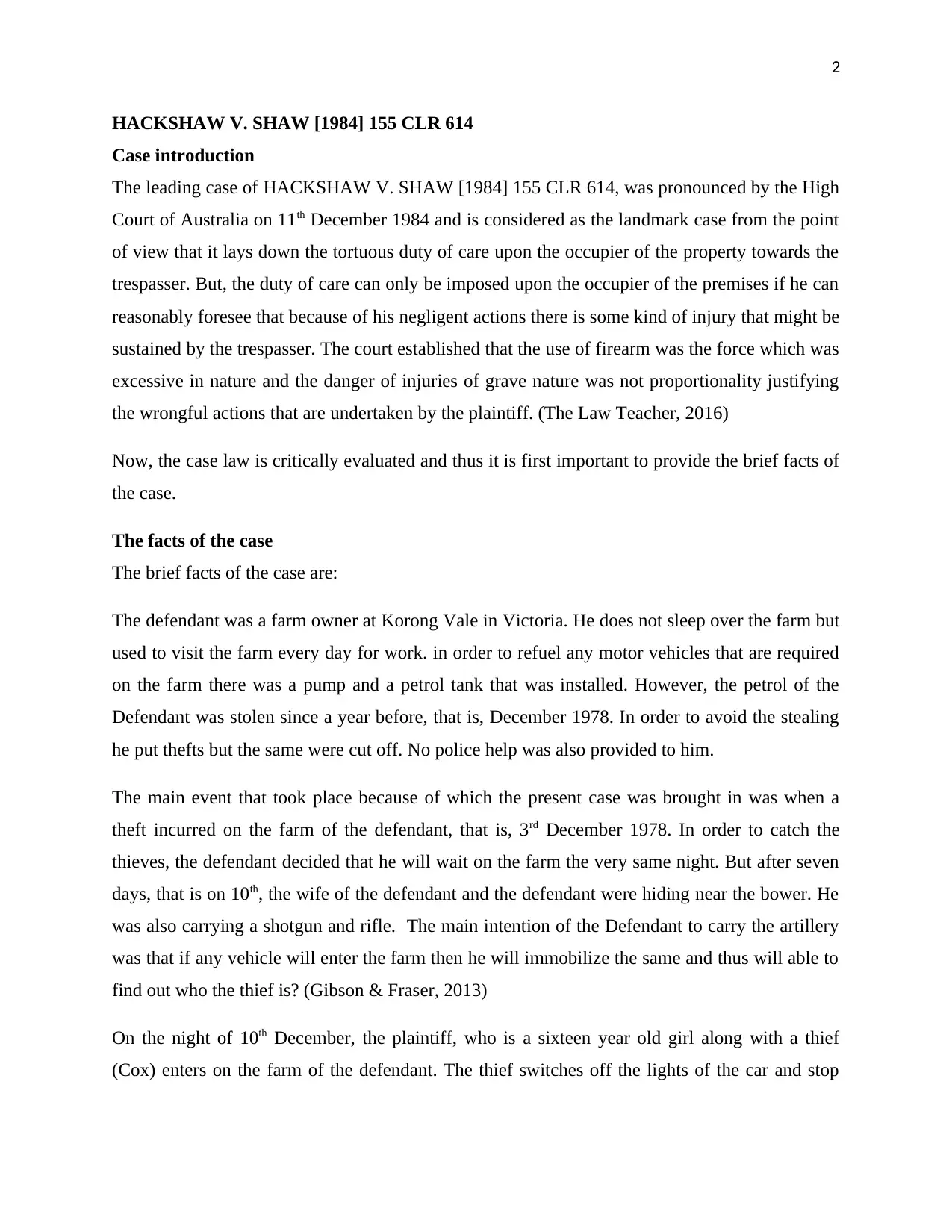
2
HACKSHAW V. SHAW [1984] 155 CLR 614
Case introduction
The leading case of HACKSHAW V. SHAW [1984] 155 CLR 614, was pronounced by the High
Court of Australia on 11th December 1984 and is considered as the landmark case from the point
of view that it lays down the tortuous duty of care upon the occupier of the property towards the
trespasser. But, the duty of care can only be imposed upon the occupier of the premises if he can
reasonably foresee that because of his negligent actions there is some kind of injury that might be
sustained by the trespasser. The court established that the use of firearm was the force which was
excessive in nature and the danger of injuries of grave nature was not proportionality justifying
the wrongful actions that are undertaken by the plaintiff. (The Law Teacher, 2016)
Now, the case law is critically evaluated and thus it is first important to provide the brief facts of
the case.
The facts of the case
The brief facts of the case are:
The defendant was a farm owner at Korong Vale in Victoria. He does not sleep over the farm but
used to visit the farm every day for work. in order to refuel any motor vehicles that are required
on the farm there was a pump and a petrol tank that was installed. However, the petrol of the
Defendant was stolen since a year before, that is, December 1978. In order to avoid the stealing
he put thefts but the same were cut off. No police help was also provided to him.
The main event that took place because of which the present case was brought in was when a
theft incurred on the farm of the defendant, that is, 3rd December 1978. In order to catch the
thieves, the defendant decided that he will wait on the farm the very same night. But after seven
days, that is on 10th, the wife of the defendant and the defendant were hiding near the bower. He
was also carrying a shotgun and rifle. The main intention of the Defendant to carry the artillery
was that if any vehicle will enter the farm then he will immobilize the same and thus will able to
find out who the thief is? (Gibson & Fraser, 2013)
On the night of 10th December, the plaintiff, who is a sixteen year old girl along with a thief
(Cox) enters on the farm of the defendant. The thief switches off the lights of the car and stop
HACKSHAW V. SHAW [1984] 155 CLR 614
Case introduction
The leading case of HACKSHAW V. SHAW [1984] 155 CLR 614, was pronounced by the High
Court of Australia on 11th December 1984 and is considered as the landmark case from the point
of view that it lays down the tortuous duty of care upon the occupier of the property towards the
trespasser. But, the duty of care can only be imposed upon the occupier of the premises if he can
reasonably foresee that because of his negligent actions there is some kind of injury that might be
sustained by the trespasser. The court established that the use of firearm was the force which was
excessive in nature and the danger of injuries of grave nature was not proportionality justifying
the wrongful actions that are undertaken by the plaintiff. (The Law Teacher, 2016)
Now, the case law is critically evaluated and thus it is first important to provide the brief facts of
the case.
The facts of the case
The brief facts of the case are:
The defendant was a farm owner at Korong Vale in Victoria. He does not sleep over the farm but
used to visit the farm every day for work. in order to refuel any motor vehicles that are required
on the farm there was a pump and a petrol tank that was installed. However, the petrol of the
Defendant was stolen since a year before, that is, December 1978. In order to avoid the stealing
he put thefts but the same were cut off. No police help was also provided to him.
The main event that took place because of which the present case was brought in was when a
theft incurred on the farm of the defendant, that is, 3rd December 1978. In order to catch the
thieves, the defendant decided that he will wait on the farm the very same night. But after seven
days, that is on 10th, the wife of the defendant and the defendant were hiding near the bower. He
was also carrying a shotgun and rifle. The main intention of the Defendant to carry the artillery
was that if any vehicle will enter the farm then he will immobilize the same and thus will able to
find out who the thief is? (Gibson & Fraser, 2013)
On the night of 10th December, the plaintiff, who is a sixteen year old girl along with a thief
(Cox) enters on the farm of the defendant. The thief switches off the lights of the car and stop
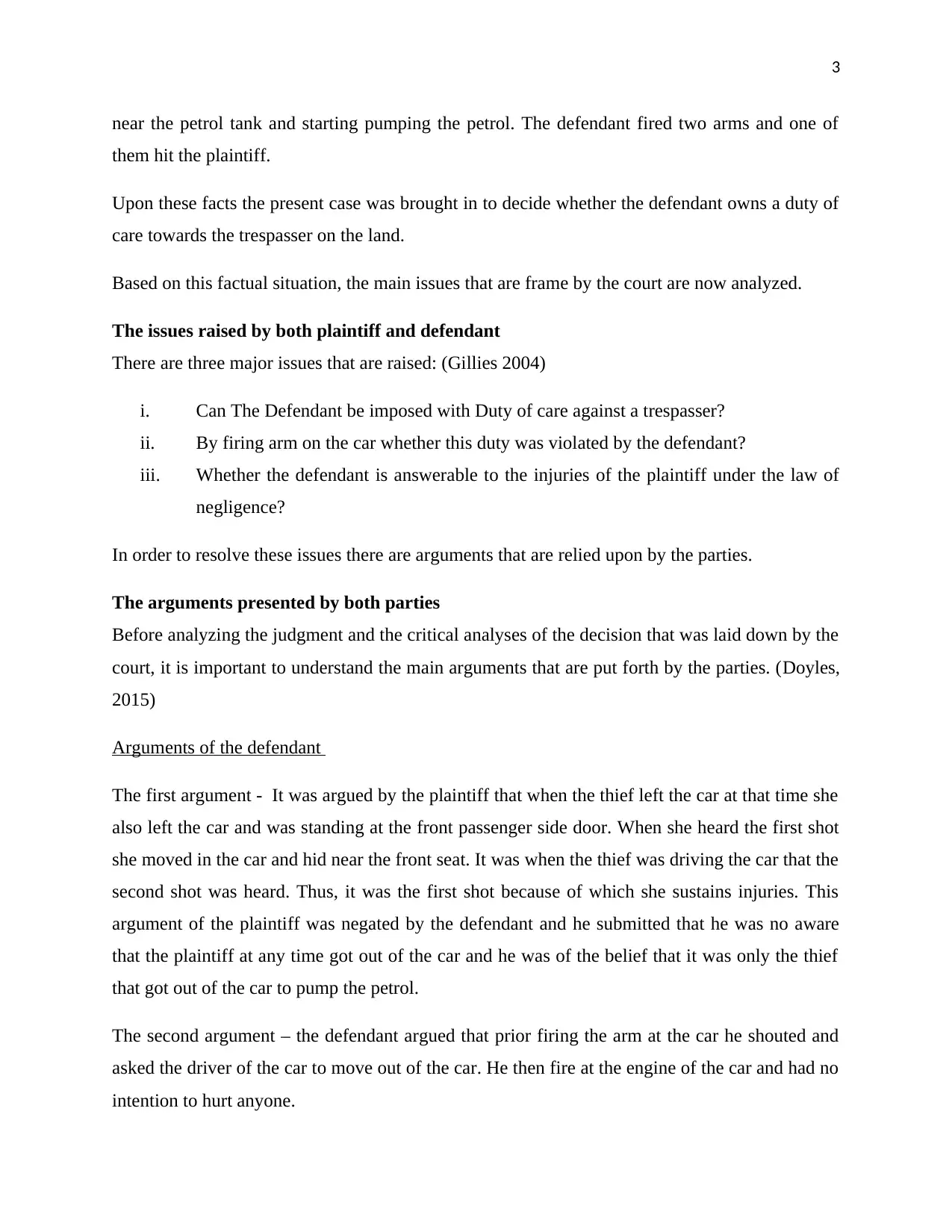
3
near the petrol tank and starting pumping the petrol. The defendant fired two arms and one of
them hit the plaintiff.
Upon these facts the present case was brought in to decide whether the defendant owns a duty of
care towards the trespasser on the land.
Based on this factual situation, the main issues that are frame by the court are now analyzed.
The issues raised by both plaintiff and defendant
There are three major issues that are raised: (Gillies 2004)
i. Can The Defendant be imposed with Duty of care against a trespasser?
ii. By firing arm on the car whether this duty was violated by the defendant?
iii. Whether the defendant is answerable to the injuries of the plaintiff under the law of
negligence?
In order to resolve these issues there are arguments that are relied upon by the parties.
The arguments presented by both parties
Before analyzing the judgment and the critical analyses of the decision that was laid down by the
court, it is important to understand the main arguments that are put forth by the parties. (Doyles,
2015)
Arguments of the defendant
The first argument - It was argued by the plaintiff that when the thief left the car at that time she
also left the car and was standing at the front passenger side door. When she heard the first shot
she moved in the car and hid near the front seat. It was when the thief was driving the car that the
second shot was heard. Thus, it was the first shot because of which she sustains injuries. This
argument of the plaintiff was negated by the defendant and he submitted that he was no aware
that the plaintiff at any time got out of the car and he was of the belief that it was only the thief
that got out of the car to pump the petrol.
The second argument – the defendant argued that prior firing the arm at the car he shouted and
asked the driver of the car to move out of the car. He then fire at the engine of the car and had no
intention to hurt anyone.
near the petrol tank and starting pumping the petrol. The defendant fired two arms and one of
them hit the plaintiff.
Upon these facts the present case was brought in to decide whether the defendant owns a duty of
care towards the trespasser on the land.
Based on this factual situation, the main issues that are frame by the court are now analyzed.
The issues raised by both plaintiff and defendant
There are three major issues that are raised: (Gillies 2004)
i. Can The Defendant be imposed with Duty of care against a trespasser?
ii. By firing arm on the car whether this duty was violated by the defendant?
iii. Whether the defendant is answerable to the injuries of the plaintiff under the law of
negligence?
In order to resolve these issues there are arguments that are relied upon by the parties.
The arguments presented by both parties
Before analyzing the judgment and the critical analyses of the decision that was laid down by the
court, it is important to understand the main arguments that are put forth by the parties. (Doyles,
2015)
Arguments of the defendant
The first argument - It was argued by the plaintiff that when the thief left the car at that time she
also left the car and was standing at the front passenger side door. When she heard the first shot
she moved in the car and hid near the front seat. It was when the thief was driving the car that the
second shot was heard. Thus, it was the first shot because of which she sustains injuries. This
argument of the plaintiff was negated by the defendant and he submitted that he was no aware
that the plaintiff at any time got out of the car and he was of the belief that it was only the thief
that got out of the car to pump the petrol.
The second argument – the defendant argued that prior firing the arm at the car he shouted and
asked the driver of the car to move out of the car. He then fire at the engine of the car and had no
intention to hurt anyone.
⊘ This is a preview!⊘
Do you want full access?
Subscribe today to unlock all pages.

Trusted by 1+ million students worldwide
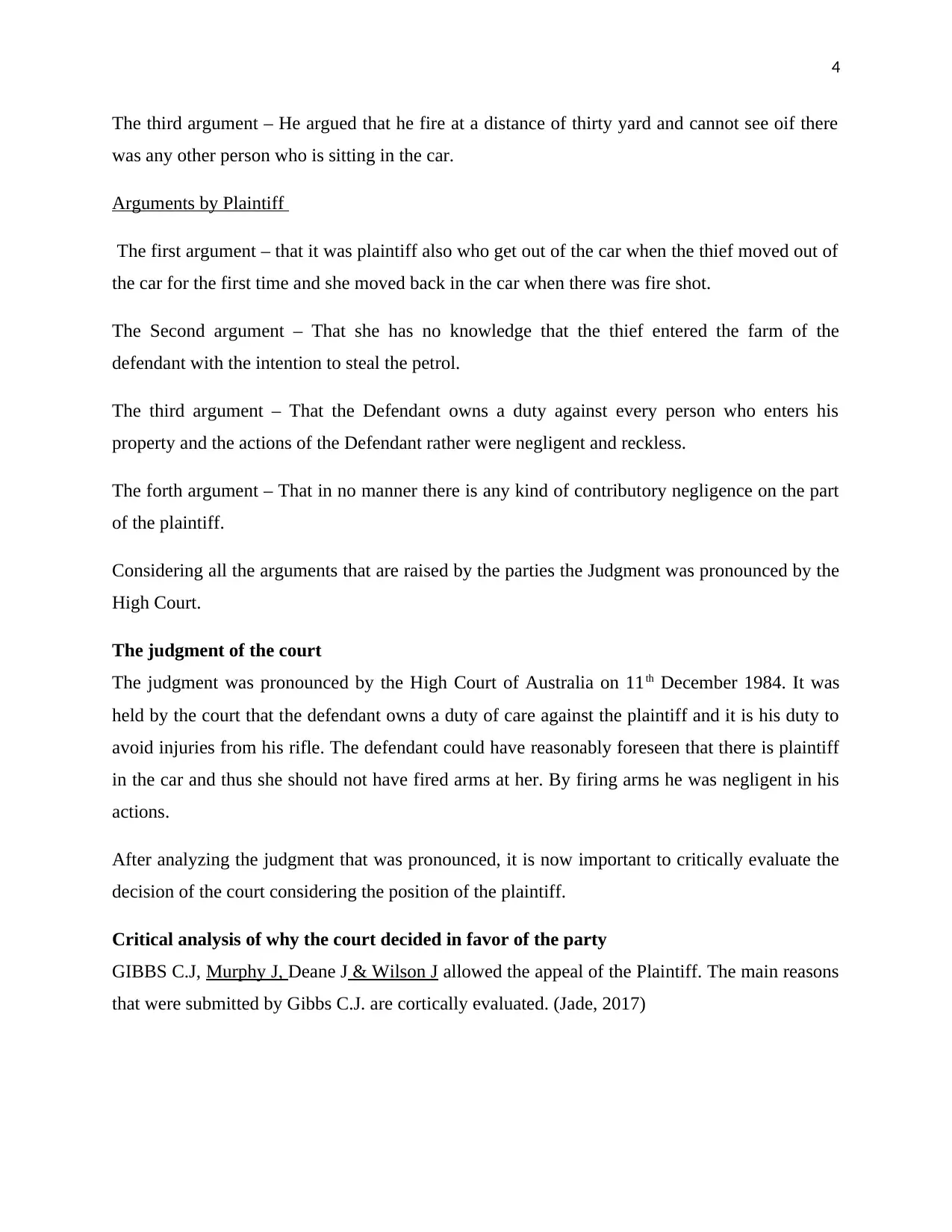
4
The third argument – He argued that he fire at a distance of thirty yard and cannot see oif there
was any other person who is sitting in the car.
Arguments by Plaintiff
The first argument – that it was plaintiff also who get out of the car when the thief moved out of
the car for the first time and she moved back in the car when there was fire shot.
The Second argument – That she has no knowledge that the thief entered the farm of the
defendant with the intention to steal the petrol.
The third argument – That the Defendant owns a duty against every person who enters his
property and the actions of the Defendant rather were negligent and reckless.
The forth argument – That in no manner there is any kind of contributory negligence on the part
of the plaintiff.
Considering all the arguments that are raised by the parties the Judgment was pronounced by the
High Court.
The judgment of the court
The judgment was pronounced by the High Court of Australia on 11th December 1984. It was
held by the court that the defendant owns a duty of care against the plaintiff and it is his duty to
avoid injuries from his rifle. The defendant could have reasonably foreseen that there is plaintiff
in the car and thus she should not have fired arms at her. By firing arms he was negligent in his
actions.
After analyzing the judgment that was pronounced, it is now important to critically evaluate the
decision of the court considering the position of the plaintiff.
Critical analysis of why the court decided in favor of the party
GIBBS C.J, Murphy J, Deane J & Wilson J allowed the appeal of the Plaintiff. The main reasons
that were submitted by Gibbs C.J. are cortically evaluated. (Jade, 2017)
The third argument – He argued that he fire at a distance of thirty yard and cannot see oif there
was any other person who is sitting in the car.
Arguments by Plaintiff
The first argument – that it was plaintiff also who get out of the car when the thief moved out of
the car for the first time and she moved back in the car when there was fire shot.
The Second argument – That she has no knowledge that the thief entered the farm of the
defendant with the intention to steal the petrol.
The third argument – That the Defendant owns a duty against every person who enters his
property and the actions of the Defendant rather were negligent and reckless.
The forth argument – That in no manner there is any kind of contributory negligence on the part
of the plaintiff.
Considering all the arguments that are raised by the parties the Judgment was pronounced by the
High Court.
The judgment of the court
The judgment was pronounced by the High Court of Australia on 11th December 1984. It was
held by the court that the defendant owns a duty of care against the plaintiff and it is his duty to
avoid injuries from his rifle. The defendant could have reasonably foreseen that there is plaintiff
in the car and thus she should not have fired arms at her. By firing arms he was negligent in his
actions.
After analyzing the judgment that was pronounced, it is now important to critically evaluate the
decision of the court considering the position of the plaintiff.
Critical analysis of why the court decided in favor of the party
GIBBS C.J, Murphy J, Deane J & Wilson J allowed the appeal of the Plaintiff. The main reasons
that were submitted by Gibbs C.J. are cortically evaluated. (Jade, 2017)
Paraphrase This Document
Need a fresh take? Get an instant paraphrase of this document with our AI Paraphraser
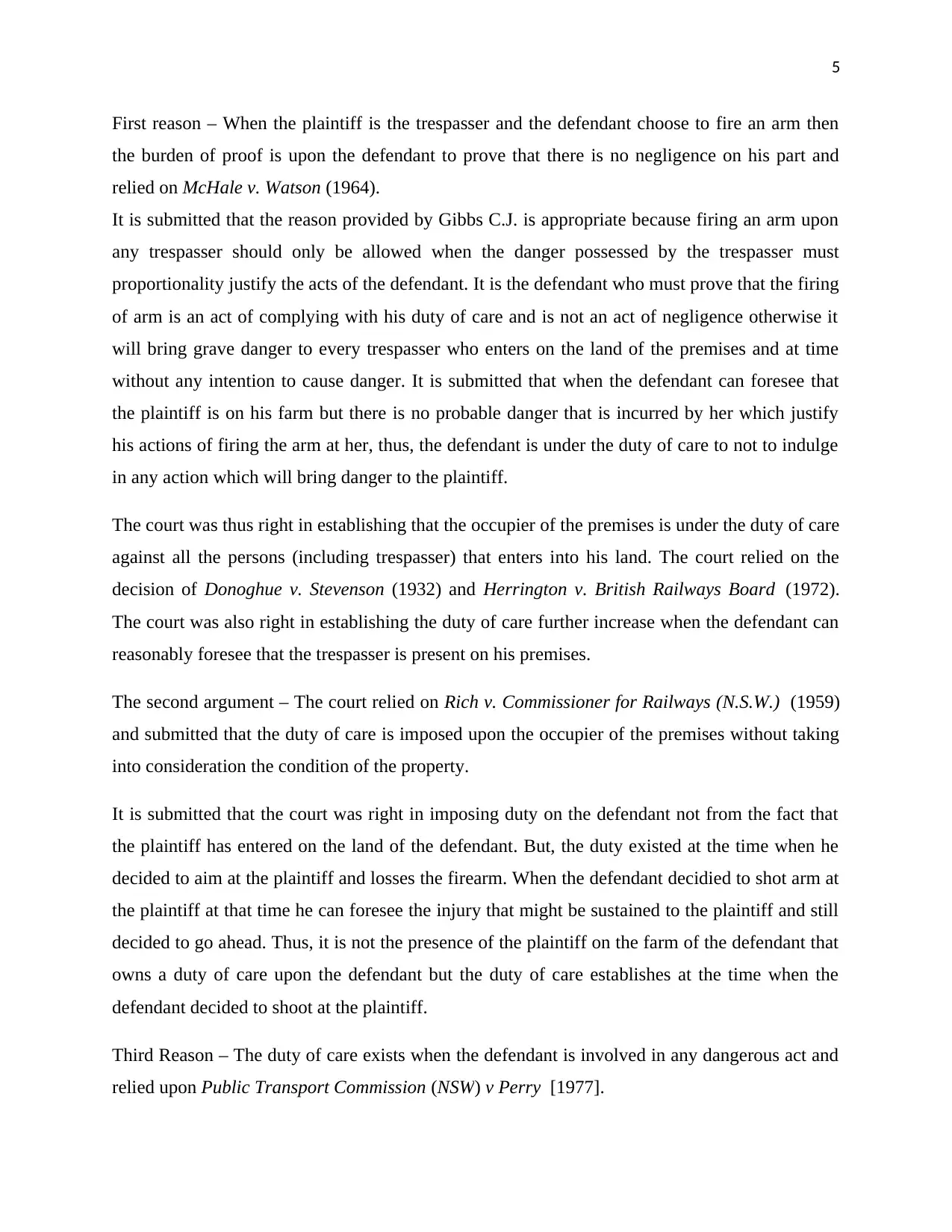
5
First reason – When the plaintiff is the trespasser and the defendant choose to fire an arm then
the burden of proof is upon the defendant to prove that there is no negligence on his part and
relied on McHale v. Watson (1964).
It is submitted that the reason provided by Gibbs C.J. is appropriate because firing an arm upon
any trespasser should only be allowed when the danger possessed by the trespasser must
proportionality justify the acts of the defendant. It is the defendant who must prove that the firing
of arm is an act of complying with his duty of care and is not an act of negligence otherwise it
will bring grave danger to every trespasser who enters on the land of the premises and at time
without any intention to cause danger. It is submitted that when the defendant can foresee that
the plaintiff is on his farm but there is no probable danger that is incurred by her which justify
his actions of firing the arm at her, thus, the defendant is under the duty of care to not to indulge
in any action which will bring danger to the plaintiff.
The court was thus right in establishing that the occupier of the premises is under the duty of care
against all the persons (including trespasser) that enters into his land. The court relied on the
decision of Donoghue v. Stevenson (1932) and Herrington v. British Railways Board (1972).
The court was also right in establishing the duty of care further increase when the defendant can
reasonably foresee that the trespasser is present on his premises.
The second argument – The court relied on Rich v. Commissioner for Railways (N.S.W.) (1959)
and submitted that the duty of care is imposed upon the occupier of the premises without taking
into consideration the condition of the property.
It is submitted that the court was right in imposing duty on the defendant not from the fact that
the plaintiff has entered on the land of the defendant. But, the duty existed at the time when he
decided to aim at the plaintiff and losses the firearm. When the defendant decidied to shot arm at
the plaintiff at that time he can foresee the injury that might be sustained to the plaintiff and still
decided to go ahead. Thus, it is not the presence of the plaintiff on the farm of the defendant that
owns a duty of care upon the defendant but the duty of care establishes at the time when the
defendant decided to shoot at the plaintiff.
Third Reason – The duty of care exists when the defendant is involved in any dangerous act and
relied upon Public Transport Commission (NSW) v Perry [1977].
First reason – When the plaintiff is the trespasser and the defendant choose to fire an arm then
the burden of proof is upon the defendant to prove that there is no negligence on his part and
relied on McHale v. Watson (1964).
It is submitted that the reason provided by Gibbs C.J. is appropriate because firing an arm upon
any trespasser should only be allowed when the danger possessed by the trespasser must
proportionality justify the acts of the defendant. It is the defendant who must prove that the firing
of arm is an act of complying with his duty of care and is not an act of negligence otherwise it
will bring grave danger to every trespasser who enters on the land of the premises and at time
without any intention to cause danger. It is submitted that when the defendant can foresee that
the plaintiff is on his farm but there is no probable danger that is incurred by her which justify
his actions of firing the arm at her, thus, the defendant is under the duty of care to not to indulge
in any action which will bring danger to the plaintiff.
The court was thus right in establishing that the occupier of the premises is under the duty of care
against all the persons (including trespasser) that enters into his land. The court relied on the
decision of Donoghue v. Stevenson (1932) and Herrington v. British Railways Board (1972).
The court was also right in establishing the duty of care further increase when the defendant can
reasonably foresee that the trespasser is present on his premises.
The second argument – The court relied on Rich v. Commissioner for Railways (N.S.W.) (1959)
and submitted that the duty of care is imposed upon the occupier of the premises without taking
into consideration the condition of the property.
It is submitted that the court was right in imposing duty on the defendant not from the fact that
the plaintiff has entered on the land of the defendant. But, the duty existed at the time when he
decided to aim at the plaintiff and losses the firearm. When the defendant decidied to shot arm at
the plaintiff at that time he can foresee the injury that might be sustained to the plaintiff and still
decided to go ahead. Thus, it is not the presence of the plaintiff on the farm of the defendant that
owns a duty of care upon the defendant but the duty of care establishes at the time when the
defendant decided to shoot at the plaintiff.
Third Reason – The duty of care exists when the defendant is involved in any dangerous act and
relied upon Public Transport Commission (NSW) v Perry [1977].
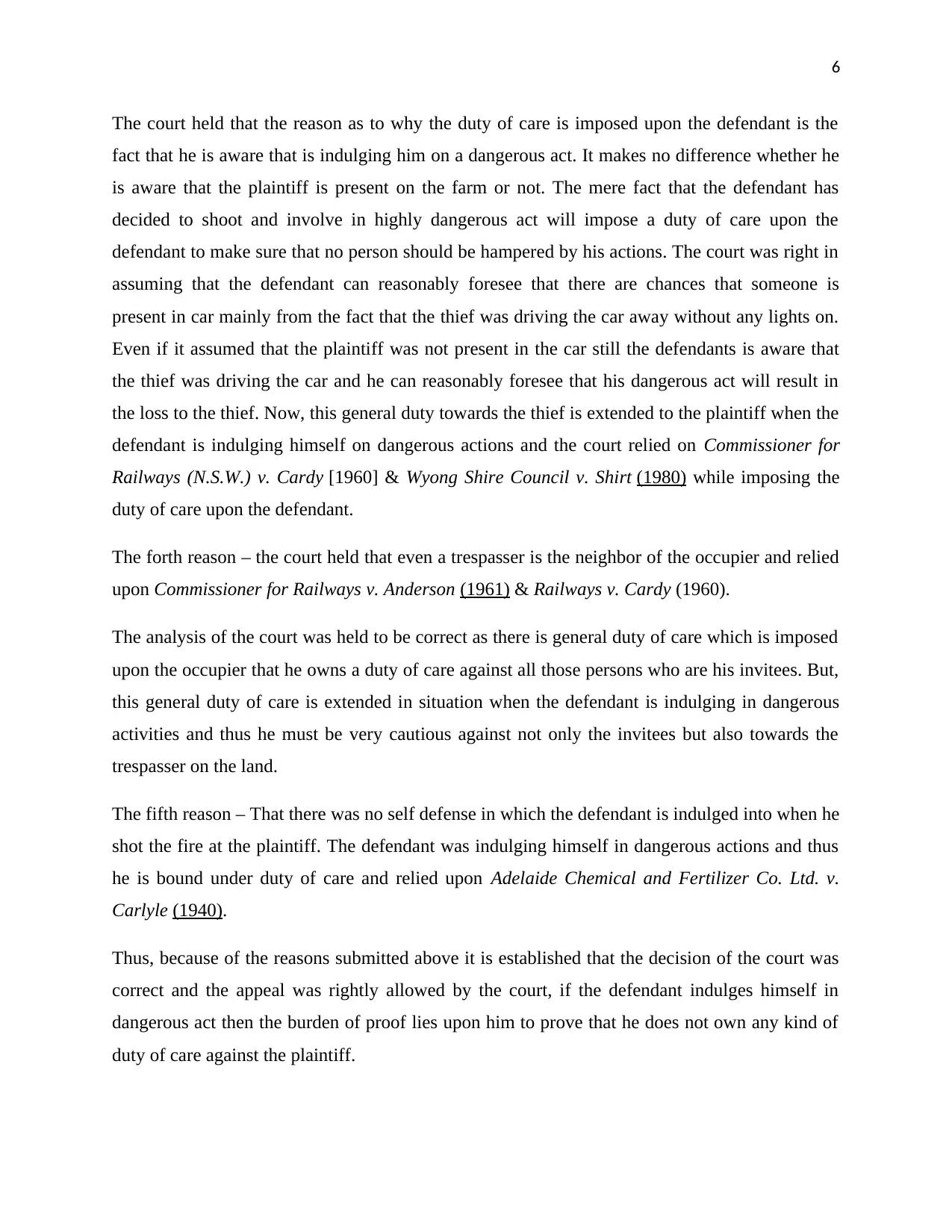
6
The court held that the reason as to why the duty of care is imposed upon the defendant is the
fact that he is aware that is indulging him on a dangerous act. It makes no difference whether he
is aware that the plaintiff is present on the farm or not. The mere fact that the defendant has
decided to shoot and involve in highly dangerous act will impose a duty of care upon the
defendant to make sure that no person should be hampered by his actions. The court was right in
assuming that the defendant can reasonably foresee that there are chances that someone is
present in car mainly from the fact that the thief was driving the car away without any lights on.
Even if it assumed that the plaintiff was not present in the car still the defendants is aware that
the thief was driving the car and he can reasonably foresee that his dangerous act will result in
the loss to the thief. Now, this general duty towards the thief is extended to the plaintiff when the
defendant is indulging himself on dangerous actions and the court relied on Commissioner for
Railways (N.S.W.) v. Cardy [1960] & Wyong Shire Council v. Shirt (1980) while imposing the
duty of care upon the defendant.
The forth reason – the court held that even a trespasser is the neighbor of the occupier and relied
upon Commissioner for Railways v. Anderson (1961) & Railways v. Cardy (1960).
The analysis of the court was held to be correct as there is general duty of care which is imposed
upon the occupier that he owns a duty of care against all those persons who are his invitees. But,
this general duty of care is extended in situation when the defendant is indulging in dangerous
activities and thus he must be very cautious against not only the invitees but also towards the
trespasser on the land.
The fifth reason – That there was no self defense in which the defendant is indulged into when he
shot the fire at the plaintiff. The defendant was indulging himself in dangerous actions and thus
he is bound under duty of care and relied upon Adelaide Chemical and Fertilizer Co. Ltd. v.
Carlyle (1940).
Thus, because of the reasons submitted above it is established that the decision of the court was
correct and the appeal was rightly allowed by the court, if the defendant indulges himself in
dangerous act then the burden of proof lies upon him to prove that he does not own any kind of
duty of care against the plaintiff.
The court held that the reason as to why the duty of care is imposed upon the defendant is the
fact that he is aware that is indulging him on a dangerous act. It makes no difference whether he
is aware that the plaintiff is present on the farm or not. The mere fact that the defendant has
decided to shoot and involve in highly dangerous act will impose a duty of care upon the
defendant to make sure that no person should be hampered by his actions. The court was right in
assuming that the defendant can reasonably foresee that there are chances that someone is
present in car mainly from the fact that the thief was driving the car away without any lights on.
Even if it assumed that the plaintiff was not present in the car still the defendants is aware that
the thief was driving the car and he can reasonably foresee that his dangerous act will result in
the loss to the thief. Now, this general duty towards the thief is extended to the plaintiff when the
defendant is indulging himself on dangerous actions and the court relied on Commissioner for
Railways (N.S.W.) v. Cardy [1960] & Wyong Shire Council v. Shirt (1980) while imposing the
duty of care upon the defendant.
The forth reason – the court held that even a trespasser is the neighbor of the occupier and relied
upon Commissioner for Railways v. Anderson (1961) & Railways v. Cardy (1960).
The analysis of the court was held to be correct as there is general duty of care which is imposed
upon the occupier that he owns a duty of care against all those persons who are his invitees. But,
this general duty of care is extended in situation when the defendant is indulging in dangerous
activities and thus he must be very cautious against not only the invitees but also towards the
trespasser on the land.
The fifth reason – That there was no self defense in which the defendant is indulged into when he
shot the fire at the plaintiff. The defendant was indulging himself in dangerous actions and thus
he is bound under duty of care and relied upon Adelaide Chemical and Fertilizer Co. Ltd. v.
Carlyle (1940).
Thus, because of the reasons submitted above it is established that the decision of the court was
correct and the appeal was rightly allowed by the court, if the defendant indulges himself in
dangerous act then the burden of proof lies upon him to prove that he does not own any kind of
duty of care against the plaintiff.
⊘ This is a preview!⊘
Do you want full access?
Subscribe today to unlock all pages.

Trusted by 1+ million students worldwide
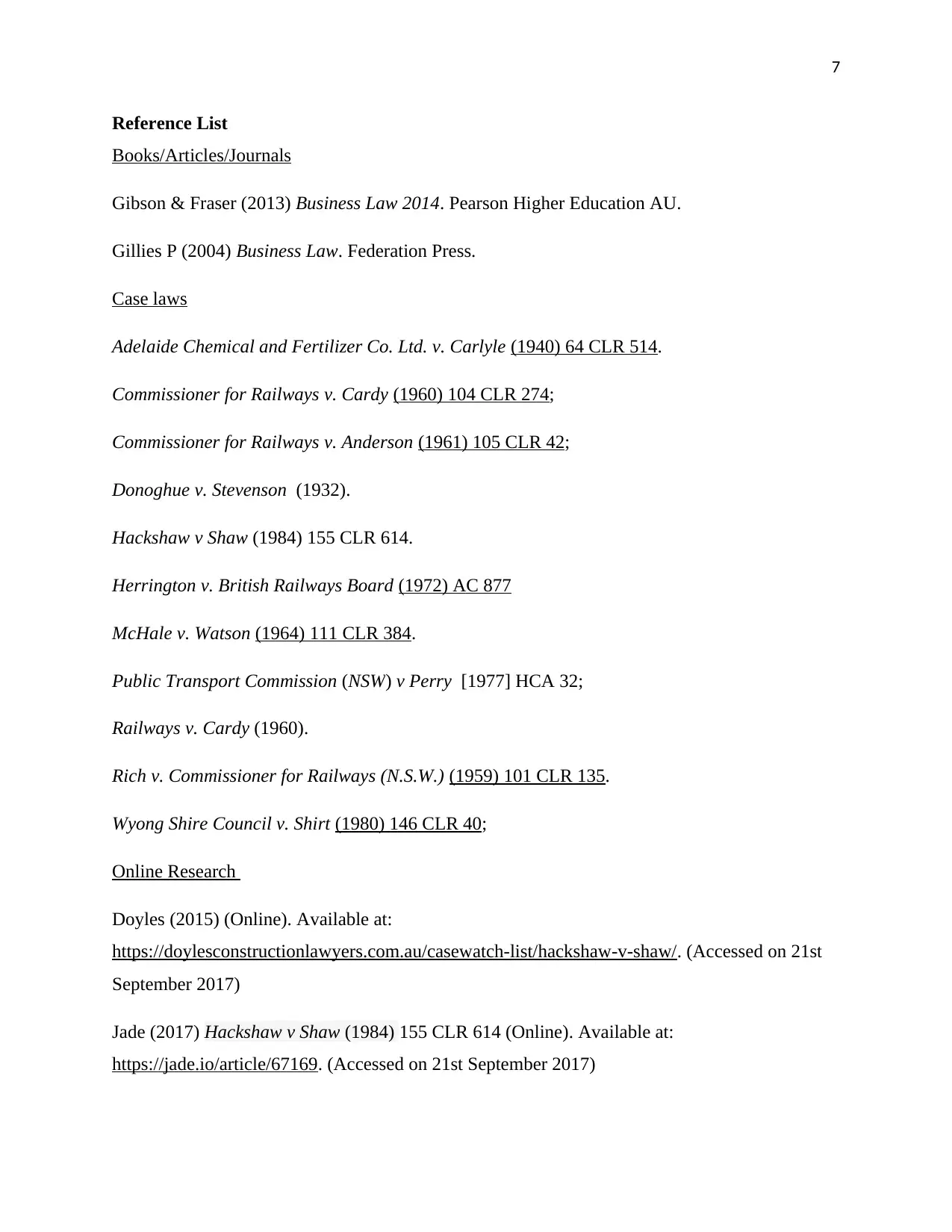
7
Reference List
Books/Articles/Journals
Gibson & Fraser (2013) Business Law 2014. Pearson Higher Education AU.
Gillies P (2004) Business Law. Federation Press.
Case laws
Adelaide Chemical and Fertilizer Co. Ltd. v. Carlyle (1940) 64 CLR 514.
Commissioner for Railways v. Cardy (1960) 104 CLR 274;
Commissioner for Railways v. Anderson (1961) 105 CLR 42;
Donoghue v. Stevenson (1932).
Hackshaw v Shaw (1984) 155 CLR 614.
Herrington v. British Railways Board (1972) AC 877
McHale v. Watson (1964) 111 CLR 384.
Public Transport Commission (NSW) v Perry [1977] HCA 32;
Railways v. Cardy (1960).
Rich v. Commissioner for Railways (N.S.W.) (1959) 101 CLR 135.
Wyong Shire Council v. Shirt (1980) 146 CLR 40;
Online Research
Doyles (2015) (Online). Available at:
https://doylesconstructionlawyers.com.au/casewatch-list/hackshaw-v-shaw/. (Accessed on 21st
September 2017)
Jade (2017) Hackshaw v Shaw (1984) 155 CLR 614 (Online). Available at:
https://jade.io/article/67169. (Accessed on 21st September 2017)
Reference List
Books/Articles/Journals
Gibson & Fraser (2013) Business Law 2014. Pearson Higher Education AU.
Gillies P (2004) Business Law. Federation Press.
Case laws
Adelaide Chemical and Fertilizer Co. Ltd. v. Carlyle (1940) 64 CLR 514.
Commissioner for Railways v. Cardy (1960) 104 CLR 274;
Commissioner for Railways v. Anderson (1961) 105 CLR 42;
Donoghue v. Stevenson (1932).
Hackshaw v Shaw (1984) 155 CLR 614.
Herrington v. British Railways Board (1972) AC 877
McHale v. Watson (1964) 111 CLR 384.
Public Transport Commission (NSW) v Perry [1977] HCA 32;
Railways v. Cardy (1960).
Rich v. Commissioner for Railways (N.S.W.) (1959) 101 CLR 135.
Wyong Shire Council v. Shirt (1980) 146 CLR 40;
Online Research
Doyles (2015) (Online). Available at:
https://doylesconstructionlawyers.com.au/casewatch-list/hackshaw-v-shaw/. (Accessed on 21st
September 2017)
Jade (2017) Hackshaw v Shaw (1984) 155 CLR 614 (Online). Available at:
https://jade.io/article/67169. (Accessed on 21st September 2017)
Paraphrase This Document
Need a fresh take? Get an instant paraphrase of this document with our AI Paraphraser
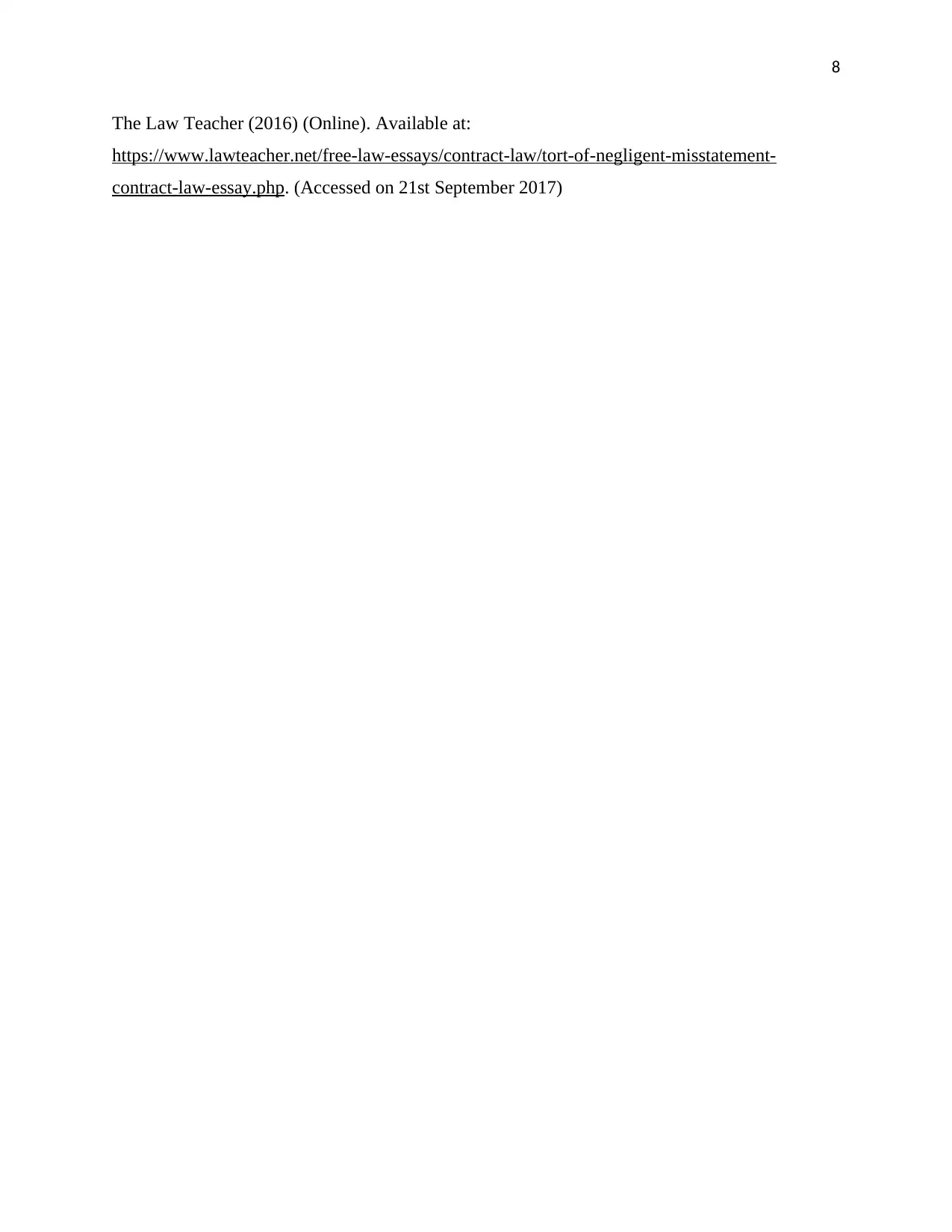
8
The Law Teacher (2016) (Online). Available at:
https://www.lawteacher.net/free-law-essays/contract-law/tort-of-negligent-misstatement-
contract-law-essay.php. (Accessed on 21st September 2017)
The Law Teacher (2016) (Online). Available at:
https://www.lawteacher.net/free-law-essays/contract-law/tort-of-negligent-misstatement-
contract-law-essay.php. (Accessed on 21st September 2017)
1 out of 8
Your All-in-One AI-Powered Toolkit for Academic Success.
+13062052269
info@desklib.com
Available 24*7 on WhatsApp / Email
![[object Object]](/_next/static/media/star-bottom.7253800d.svg)
Unlock your academic potential
Copyright © 2020–2025 A2Z Services. All Rights Reserved. Developed and managed by ZUCOL.


